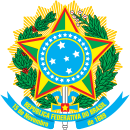 | |
| |
| Use | National flag and ensign |
|---|---|
| Proportion | 7:10 |
| Adopted |
|
| Design | A green field with a large yellow rhombus in the center, bearing a blue disk which forms a celestial globe depicting twenty-seven small white five-pointed stars spanned by a white equatorial curved band with the National Motto Ordem E Progresso ('Order and Progress') written in green. |
| Designed by | Raimundo Teixeira Mendes |
| Part of a series on the |
| Culture of Brazil |
|---|
 |
| Society |
| Topics |
| Symbols |
The national flag of Brazil is a blue disc depicting a starry sky (which includes the Southern Cross) spanned by a curved band inscribed with the national motto Ordem e Progresso ('Order and Progress'), within a yellow rhombus, on a green field. It was officially adopted on 19 November 1889, four days after the Proclamation of the Republic, to replace the flag of the Empire of Brazil. The concept was the work of Raimundo Teixeira Mendes, with the collaboration of Miguel Lemos, Manuel Pereira Reis and Décio Villares.
The green field and yellow rhombus from the previous imperial flag were preserved (though slightly modified in hue and shape). In the imperial flag, the green represented the House of Braganza of Pedro I, the first Emperor of Brazil, while the yellow represented the House of Habsburg of his wife, Empress Maria Leopoldina.[1] A blue circle with white five-pointed stars replaced the arms of the Empire of Brazil –its position in the flag reflects the sky over the city of Rio de Janeiro on 15 November 1889. The motto Ordem e Progresso is derived from Auguste Comte's motto of positivism: "L'amour pour principe et l'ordre pour base; le progrès pour but" ("Love as a principle and order as the basis; progress as the goal").[2]
Each star, corresponding to a Brazilian Federal Unit, is sized in proportion relative to its geographic size, and, according to Brazilian Law, the flag must be updated in case of the creation or extinction of a state. At the time the flag was first adopted in 1889, it had 21 stars. It then received one more star in 1960 (representing the state of Guanabara), then another in 1968 (representing Acre), and finally four more stars in 1992 (representing Amapá, Roraima, Rondônia and Tocantins), totaling 27 stars in its current version.
- ^ "Brazil — Photo Details". The World Factbook. CIA. Archived from the original on 12 January 2021. Retrieved 8 October 2010.
- ^ Catarin, Cristiano (2007). "Bandeira e significados" [Flag and meanings]. HISTORIANET (in Brazilian Portuguese). Archived from the original on 7 December 2007. Retrieved 9 October 2010.